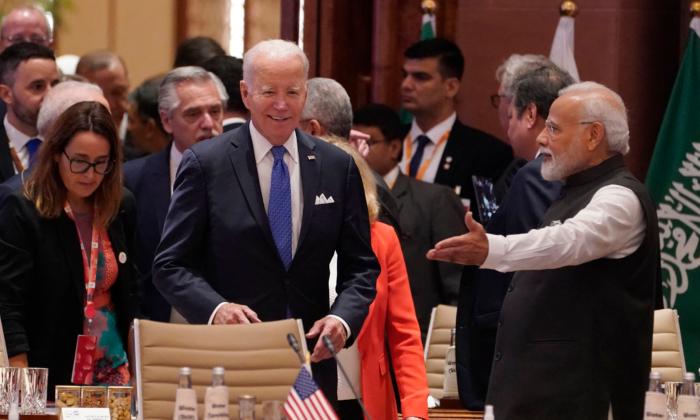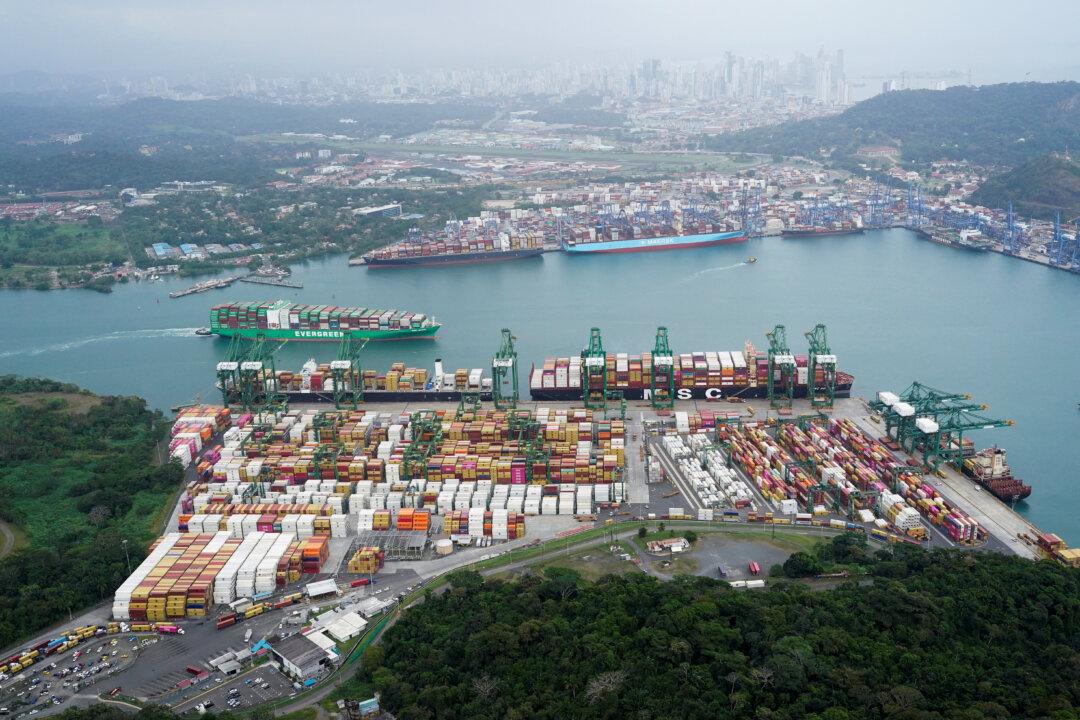The Biden administration has engaged in a number of strategic policy initiatives that, while promising, appear to not have been planned deeply or executed strongly at the high levels of government.
Does the new India–Middle East–Europe Economic Corridor (IMEC) strategic partnership fall into this category?
The administration also entered into the Australia–UK–United States (AUKUS) security accords, for example, in September 2021 without a significant understanding at the White House level of the global potential of this treaty for the United States. The potential of that treaty was certainly grasped by the Australian and U.S. military leaderships and the UK government as a whole but has been essentially downplayed by the Biden leadership team.
AUKUS is the only truly global strategic treaty, giving three allies comprehensive and coordinated military superiority in the North and South Atlantic, the Mediterranean, the Indian Ocean, the North and South Pacific, and the polar regions. No other military treaty in the world had ever achieved that. It’s irrelevant to claim that AUKUS is a security pact and the IMEC a trade and infrastructure accord; all international modalities at this scale are security pacts.
What’s significant is that the new IMEC pact—beginning with a memorandum of understanding (MOU), signed on the sidelines of the G20 summit in New Delhi on Sept. 9–10—has no visible pointers to U.S. strategic benefits (it doesn’t provide for the corridor to reach the United States in a way that’s more efficient than existing lines), nor does it link to AUKUS. In other words, there appears to be no “joined-up” thinking in U.S. strategic planning.

Moreover, the pact doesn’t consider the broader approach of the proposed RedMed (Red Sea-Mediterranean) transit and economic zone proposed in 2016, which includes some of the same players as the IMEC but also comprehensively uniting a trading/transit zone that included Ethiopia, Eritrea, Sudan, and Egypt, as well as the Arabian Peninsula and Levant states included in part in the IMEC.
U.S. President Joe Biden’s initiative to create the IMEC emerged as a problematic, hasty, incomplete, and highly political gesture to spearhead a revived U.S. presence in the Middle East and ostensibly to counter the now near-bankrupt Belt and Road Initiative (BRI) of China. The BRI, insofar as it touched on some of the same areas as the IMEC, had the benefit of a lineup of connected states that linked directly back to mainland China from Africa and the Middle East.
How the IMEC was introduced immediately created a number of enemies for the pact and highlighted a number of major gaps, including the role of the United States in the corridor.
Signatories to the new initiative were the governments of the Kingdom of Saudi Arabia, the European Union, the Republic of India, the United Arab Emirates (UAE), the French Republic, the Federal Republic of Germany, the Italian Republic, and the United States of America. They were to meet within 60 days to establish an “action plan” of modalities. Significantly, France, Germany, and Italy are members of the EU, which also signed the IMEC MOU separately.
Pointed omissions in the initiative were the UK, Greece, Turkey, Israel, Oman, and Egypt. The omission of Iran was understood on the grounds of the unresolved hostility between the United States and Iran. The MOU showed, particularly with the omission of the UK (the United States’ supposed closest ally and a member of AUKUS), that it was a pointed reflection of the Biden administration’s fundamentally unfavorable attitude toward Britain, which would be a logical anchor and major trading partner in the supposed IMEC line.
However, the MOU also showed a lack of geographic contiguity, avoiding Egypt, the Suez Canal, and the Red Sea region as partners, implying that the IMEC must reach the Mediterranean via Syria and possibly Lebanon, although it was stated that it would go through Israel.
Why, then, was Israel not included in the IMEC MOU? Israeli Prime Minister Benjamin Netanyahu met on the sidelines of the U.N. General Assembly in New York on Sept. 20 with President Biden, and both noted that the normalization of Israel–Saudi Arabia relations was the major topic. But no mention was made of the IMEC.
Why, too, didn’t the MOU extend to include Australia, arguably one of the United States’ closest allies (and one of the three partners in AUKUS) and a natural Indian Ocean partner with India, the supposed eastern hub of the IMEC? For that matter, why was Indonesia omitted? Australian Prime Minister Anthony Albanese was in New Delhi for the G20 summit and could have indicated an interest in the MOU—if he had been asked.
“We say there is no corridor without Turkey,” Turkish President Recep Tayyip Erdogan said in New Delhi. “Turkey is an important production and trade base. The most convenient line for traffic from east to west has to pass through Turkey.”

Significantly, Turkey was also omitted from the new Russian–Indian International North–South Transport Corridor (INSTC), which reaches the Indian Ocean via Iran. Arguably, it was the INSTC that the new IMEC initiative was intended to rival, given that the INSTC already provided a riverine, rail, and oceanic link from Western Europe (St. Petersburg) to Mumbai, India. Washington intended to punish Turkey, just as Russia pointedly bypassed Turkey in its game-changing new transit route.
It was natural that the signatories to the new IMEC would commit to it: It was a no-lose situation that presumably calls for significant U.S. investment in infrastructure for intra-regional logistics. From Washington’s standpoint, the MOU signified that the Biden administration was willing to buy back some of the friendship it once had with the UAE and Saudi Arabia and to show that Washington could match Russia’s commitment to build a supply line that would benefit India.
Does Washington expect India to forgo or reduce in importance its years of major economic commitment to building a supply line linking India through Iran to Central Asia and to Russia? There’s no indication that New Delhi has any intention of forgoing its historical need and desire to reach into Central Asia and to ensure solid lines of communication with Russia, even at the cost of Russia’s eventually using its terminus on the Iranian coast near the Strait of Hormuz to build a naval support facility.
Meanwhile, the White House stated: “The IMEC will be comprised of two separate corridors, the east corridor connecting India to the Arabian Gulf and the northern corridor connecting the Arabian Gulf to Europe. It will include a railway that, upon completion, will provide a reliable and cost-effective cross-border ship-to-rail transit network to supplement existing maritime and road transport routes—enabling goods and services to transit to, from, and between India, the UAE, Saudi Arabia, Jordan, Israel, and Europe.
“Along the railway route, Participants intend to enable the laying of cable for electricity and digital connectivity, as well as pipe for clean hydrogen export. This corridor will secure regional supply chains, increase trade accessibility, improve trade facilitation, and support an increased emphasis on environmental social, and government impacts.
“Participants intend that the corridor will increase efficiencies, reduce costs, enhance economic unity, generate jobs, and lower greenhouse gas emissions—resulting in a transformative integration of Asia, Europe and the Middle East.
“In support of this initiative, Participants commit to work collectively and expeditiously to arrange and implement all elements of these new transit two routes, and to establish coordinating entities to address the full range of technical, design, financing, legal and relevant regulatory standards.”
The statement clearly reflected U.S. political priorities on “clean energy,” which India and the Middle East participants were happy to sign even though they’ve shown little prioritization of them.






